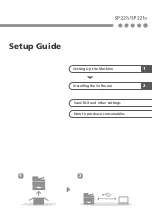
7 - English
FCC Telephone Consumer Protection Act
The Telephone Consumer Protection Act of 1991 makes it
unlawful for any person to use a computer or other
electronic device, including FAX machines, to send any
message unless such message clearly contains in a margin
at the top or bottom of each transmitted page or on the first
page of the transmission, the date and time it is sent and an
identification of the business or other entity, or other
individual sending the message, and the telephone number
of the sending machine or such business, other entity, or
individual. (The telehone number provided may not be a 900
number or any other number for which charges exceed local
or long-distance transmission charges.)
To comply with this law, you must enter the following
information in your fax unit:
•
Date and time:
see “Changing the Date and Time” under
Setting Your Terminal in the User’s Guide for instructions
on doing this.
•
Name and telephone number which identify the source
of your fax transmission:
see Your fax number/your
name under Setting Your Terminal in the User’s Guide for
instructions on doing this.
FCC Radio Frequency Interference Statement for
120-Volt Models
WARNING: This equipment has been tested and found to
comply with the limits for a Class B digital device, pursuant
to Part 15 of the FCC rules. These limits are designed to
provide reasonable protection against harmful interference
in a residential installation. This equipment generates, uses
and can radiate radio frequency energy and, if not installed
and used in accordance with the instructions, may cause
harmful interference to radio communications. However,
there is no guarantee that interference will not occur in a
particular installation. If this equipment does cause harmful
interference to radio or television reception, which can be
determined by turning the equipment off and on, the user is
encouraged to try to correct the interference by one or more
of the following measures:
• Reorient or relocate the receiving antenna.
• Increase the separation between the equipment and the
receiver.
• Plug the unit into an outlet on a circuit different from that
to which the receiver is connected.
• Consult the dealer or an experienced radio/television
technician for help.
Note:
It is the responsibility of the user to obtain the
required shielded cable in order to ensure
compliance of this equipment with FCC regulations.
Changes or modifications not expressly approved by Oki
Data may void your authority to operate this device.
FCC Radio Frequency Interference Statement for
220/240-Volt Models
WARNING: This equipment has been tested and found to
comply with the limits for a Class A digital device, pursuant
to Part 15 of the FCC rules. These limits are designed to
provide reasonable protection against harmful interference
in a commercial environment. This equipment generates,
uses and can radiate radio frequency energy and, if not
installed and used in accordance with the instructions, may
cause harmful interference to radio communications.
Operation of this equipment in a residential area is likely to
cause harmful interference in which case the user will be
required to correct the interference at their own expense.
Note:
It is the responsibility of the user to obtain the
required shielded cable in order to ensure
compliance of this equipment with FCC regulations.
Changes or modifications not expressly approved by Oki
Data may void your authority to operate this device.
California Requirement
Perchlorate Warning Applicable to Lithium Batteries
Sold and/or Distributed in California
Perchlorate Material: special handling may apply.
See www.dtsc.ca.gov/hazardouswaste/perchlorate.
Industry Canada (IC) Radio Interference
Statements
120-Volt Models
This Oki Data apparatus complies with the Class B limits for
radio interference as specified in the IC Radio Interference
Regulations.
220/240-Volt Models
This Oki Data apparatus complies with the Class A limits for
radio interference as specified in the IC Radio Interference
Regulations.
Industry Canada (IC) Requirements for End
Users
This product meets the applicable Industry Canada technical
specifications.
The Ringer Equivalence Number is an indication of the
maximum number of devices allowed to be connected to a
telephone interface. The termination on an interface may
consist of any combination of devices subject only to the
requirement that the sum of the RENs of all the devices does
not exceed five.
European Union Council of the European
Communities Statements of Conformance
for 220/240-Volt Models
Electromagnetic Conformance
This product complies with the requirements of the Council
Directive 89/336/EEC on the approximation of the laws of
the member states relating to electromagnetic compatibility.
Safety Conformance
This product is in conformity with Directive 73/23/EEC on
the harmonization of the laws of Member States relating to
electrical equipment designed for use within certain voltage
limits.








































